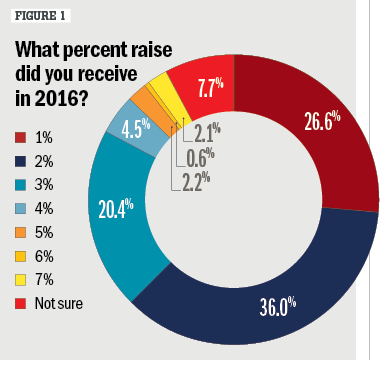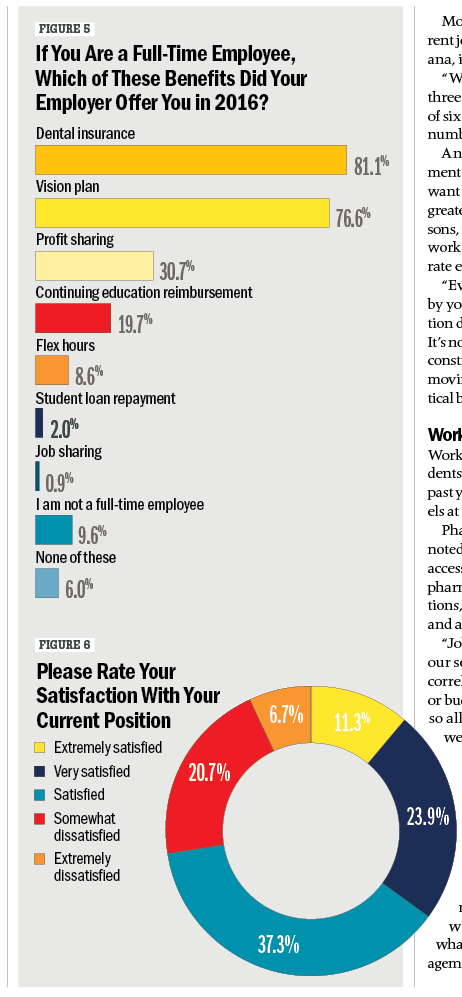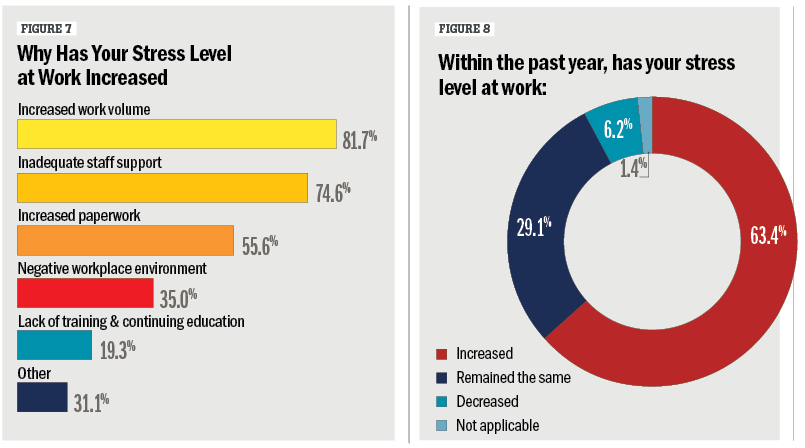Pharmacy Salary Survey 2016
Stress remains a pressing issue, but most community pharmacists are satisfied with compensation and working conditions.
Results of the 2016 Pharmacist Compensation Survey are in and the picture is not uniformly positive. Most pharmacists got a raise in 2016 and most expect to get a raise in 2017. Most are satisfied with their jobs. But most are feeling a sharp increase in job-related stress.

“Job stress has gone up exponentially since I graduated from pharmacy school 11 years ago,” said Mahmoud Zegar, PharmD, a chain pharmacy manager in the greater Chicago area. “Until the past year or two, I would strongly recommend that people consider pharmacy as a career. Now I’m not so sure there is a resounding ‘yes, go and pursue it.’ Unless there is some major change in retail pharmacy, I don’t see pharmacy as a long term viable career.”
Dr. Zegar is not alone in his doubts about the long-term viability of pharmacy practice. All of the pharmacists Drug Topics talked with had similar reservations. Chain pharmacy manager, chain pharmacist, independent, hospital pharmacist. . . all were satisfied with compensation and working conditions. And all said increasing job stress is making for an uncertain future.
“Upper management is recognizing our value, so we are moving into new areas,” said hospital pharmacy director Clint Pentz, PharmD. “In addition to dispensing, there are more clinical initiatives, more protocols that allow pharmacists to adjust doses, patient satisfaction, transition of care and more. It’s exciting stuff, but nothing is being taken off my plate and I’m not getting any more FTEs. Figuring out how to make it all work is exciting and challenging, but also tremendously stressful.”
Pharmacist demographics
A total of 3,085 pharmacists responded to the latest Pharmacist Compensation Survey. Responses were weighted toward the Southeast (29.9%) and Midwest (26.8%). Another 19.7% of respondents were from the Southwest, 18.1% from the Northeast and 4.8% from the Northwest. Just 1.5% of respondents were outside the United States.
Most respondents were female (58.9%) under 40 years old (58.2%). Another 18.1% were between 40 and 49, 13.9% were 50 to 59, 6.4% were 60 to 64, and 3.4% were 65 or older.
The vast majority of respondents, 86.1%, were employed full time and 9.9% were employed part time. The remainder were divided between unemployed (1.9%), other (1.4%), contract employee (0.5%), and temporary employee (0.3%).
Chain pharmacy was the primary practice setting for 39.9% of respondents, followed by hospital pharmacy (14.8%), supermarket pharmacy (10.7%), independent pharmacy (10.1%), and big box retail pharmacy (9.4%). Smaller percentages reported working in nursing home or long-term care settings (2.6%), government or military sites (2.1%), specialty or compounding pharmacy (1.6%), and mail order (1.4%). The remainder worked in other settings, an agglomeration of academia, ambulatory care, call center, central fill, discharge, drug information, home health, hospice, informatics, pharmacy benefit manager, and industry.

Nearly half of respondents (49.1%) were staff pharmacists, 25.2% were pharmacy managers, 9.8% were clinical pharmacists, 3.7% were chief or supervisory pharmacists, 2.7% were store owners. The balance were store managers, academics, technicians, informatics specialists, compliance directors, consultants, pharmacists-in-charge and pharmacy executives.
Only 27.9% of respondents had five years or less on the job. The next largest segment, 22%, had six to ten years working, followed by 21.3% with more than 25 years. The remainder had 11 to 15 years (12.9%), 16 to 20 years (9.5%) or 21 to 25 years (6.4%).
Most pharmacists have a PharmD (69%), which has been the de facto entry level pharmacy degree since the Accreditation council for Pharmacy Education adopted its current standard in 2000. Only 9.6% of respondents were board certified in a pharmacy specialty. And of those who are board certified, only 21.3% said that certification has helped improve their salary.
Work environment -- good and bad
Working conditions don’t seem too burdensome. Nearly two-thirds of respondents. 62.5%, got at least one raise in 2016.
- The financial outlook is slightly better for 2017. 66.9% expect a raise next year.
- Few pharmacists are working excessive numbers of hours.
- More than half of respondents, 57.7%, reported working between 40 and 44 hours weekly
- The majority, 56.7%, were paid an annual salary; 43.3% were paid on an hourly basis.
- Of those who reported an annual salary, 45.4% earned between $120,000 and $140,000 yearly-- the equivalent of $58 to $67 per hour for a 40-hour week
- Of those who reported an hourly wage, 41.7% received $61 to $70 per hour
However, income and working hours are only part of the salary story. Geography plays a role. Chain pharmacist Sue Belcher, RPh, recently left southern Texas, near the Mexican border.

“I took a 27% pay cut coming to Illinois,” she said. “There are plenty of pharmacists in this part of the Midwest, which drives pharmacist pay down. In Texas, with the pharmacist making so much more, there was much less support staff. Here in Illinois, with pharmacist pay so depressed, there is more for support staff. But there is no money for staff training in either place, which creates problems for job satisfaction.”
The good news is that more than half of respondents, 54.5%, reported additional income such as commission, bonus or profit-sharing during 2016. And pharmacists enjoyed a wide variety of benefits
The storied days of five-figure signing bonuses are history. Most pharmacists who started a new job in 2016 reported no perks at all. Only 1.5% reported a sign-on bonus. The average bonus was $13,229, ranging from $1,000 to $50,000. Just 0.9% got relocation expenses and 0.2% got a car. Some 1.2% reported other perks, ranging from “freedom from chain pharmacy hell” to stock, three weeks paid vacation instead of two weeks, full benefits for less than 40 hours of weekly work to higher hourly rates.
Job satisfaction looks good on the surface. Two-thirds of pharmacists, 67.1%, said they are not considering a job change within the next 12 months. But there are discomforting trends among the 32.9% of pharmacists who might change jobs.
Most, 67.4%, said they are dissatisfied with their current job. Pam Lipasek, RPh, a chain pharmacist in Indiana, is one of them.
“When I started at this store seven years ago, we had three pharmacists,” she explained. “Now we have a total of six hours of overlap maximum, but our prescription numbers and patient numbers continue to climb.”
Another 33.8% are looking for professional advancement while 23.8% want more income. Twenty-percent want another geographic location and 18.4% are seeking greater job security. A whopping 12.8% gave “other” reasons, ranging from bullying in the workplace to reduced working hours, lack of morale, and unrealistic corporate expectations.
“Everything you do today in a chain pharmacy is timed by your computers,” Lipasek continued. “The corporation dictates how quickly you have to finish every task. It’s not worth switching to another chain with the same constraints and a new system to learn. I’ve thought about moving to an independent pharmacy, but that’s not practical because there aren’t many of them left.”
Workload woes

Workload is a major concern. Most respondents, 72%, said their workload has increased over the past year. Similarly, 63.4% reported increased stress levels at work over the past year.
Pharmacy volume is up across all settings. Dr. Zegar noted that the Affordable Care Act (ACA) has increased access to health care, including pharmacy. The scope of pharmacy practice has expanded to include immunizations, chart reviews, medication therapy management, and a host of other new duties.
“Job stress has gone up with an increase in demand for our services and our prescription volume without any correlated increase in pharmacy staff, technician help, or budget hours,” he said. “Better training would help, so all of us can practice to the fullest of our abilities as we are legally allowed to do.”
With extra training, senior technicians can handle tasks that are usually done by pharmacists, such as pre-vaccination interviews and even drawing up vaccines. But that kind of advanced training goes well beyond the basic chain training program. It is up to each pharmacy manager to eke out hours and funding for additional staff training.
Another 13.1% of respondents reported “other” reasons for increased stress--including 13-hour days with no overlap; conference calls and meetings on what was supposed to be a day off; corporate BS; administrative pressure to decrease personnel; corporate buyouts; declining reimbursement; medication therapy management pressures; time pressure; and unrealistic expectations from customers, managers, and third party payers.
“My biggest stressors are PBMs and insurance companies,” said Greta Goldshtein, PharmD, owner of Roxbury Pharmacy in Los Angeles, CA. “They are stealing my patients into mail order, they are cutting my margins, they are hitting me with DIR (direct and indirect remuneration) fees at every opportunity.”
“As an independent, you have to provide superior service to hang onto your patients. That is staff-intensive. You must have a convenient location and you need extra staff to provide memorable service levels to your patients. And all the while, third parties are doing all they can to slash your reimbursement. Pharmacy is a wonderful profession; I love helping generations of patients. But from the business perspective, I tell young people to think again.”